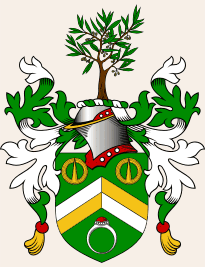|
|
|
|
|
HERALDIC PANTHER its skin was a symbol of strength
The heraldic Panther usually shown guardant is often depicted spitting fire from its mouth (and sometimes from its nostrils and its ears), referred to as incensed.
It is said that a Panther symbolizes that a beautiful woman, though fierce and intense, is very tender and loving to her brood, and will defend them with the hazard of her life and soul.
The Panther was also associated with the Greek God of wine, Dionysus; one story tells how Dionysus was nursed by panthers, and he is sometimes depicted riding a chariot drawn Panthers.
The Early Egyptians were known to sacrifice Panthers to various gods and its skin was a symbol of strength and resurrection in their funerary rites.
Throughout the ancient world mythological characters wore Panther skins; Astarte, the Phoenician goddess of procreation and birth, rode on a panther.
Some people believed that the panther once sacrificed himself so that he could give humankind the gift of spiritual awakening in the form of his skin. In Indian culture the Panther is feared and respected, and historically regarded my many cultures as the protector of the universe. |
------------------------------ ROMAN FASCES A symbol of authority
The Roman fasces, consisting of a bundle of rods (elm or ash) bound round the helve of a hatchet. The bundle of rods bound together symbolizes strength that is lacking in the single rod.
The axe symbolizes authority and leadership. Numerous governments and other authorities have used the image of the fasces for a symbol of power since the end of the Roman Empire. |
ERMINE for persons of the highest rank
Ermine is the fur of greatest estimation, and has always been used by persons of the highest rank. Holinshed speaks of its use by the representative of the sovereign, as though it would have been presumption in him to have used it in his private capacity. Swift, in his address to a lady, mentions it in a way which implies its special use by royalty: "
Should a monkey wear a crown, Must I tremble at his frown ? Could I not, through all his ermine, Spy the strutting, chattering Termin?"
Leigh alleges the use of it as a means of indicating the rank of the wearer. Thus, he says that an emperor, a king, or a prince may have the powdering as thick as he pleases; but persons of inferior degree are only permitted to wear it to a limited extent. A duke may have on his cape four ranks of black ermine spots. A marquis three rows and a half. An earl only three rows.
This fur is the skin of a small animal, which, in England, we call the stoat (Mustela erminea). It is nearly allied to the weasel, but is much larger, measuring more than nine inches in length, exclusive of its tail. Like the weasel, it preys on hares, leverets, and other game of the larger kind. It is a destructive enemy to the water-rat, following these vermin into their burrows, and killing them in large numbers. It hunts its prey by the scent. In this condition it is called the Ermine.
In Norway, Russia, and Siberia, it is hunted and taken, on account of the value of its skin, large quantities of which are continually imported into many countries. |
|
|
 THE OLIVE TREE This popular bearing has much symbolism. Chastity: In ancient Greece the newly married bride wore an olive-garland. Fecundity: The fruit of the olive is produced in vast profusion; so that olive-trees are valuable to their owners. Merit: In ancient Greece a crown of olive-twigs was the highest distinction of a citizen who had deserved well of his country. Peace: An olive branch was anciently a symbol of peace. The vanquished that sued for peace carried olive branches in their hands. An olive-twig in the hands of a king (on medals), as in the case of Numa, indicated a reign of peace. Victory: The highest prize in the Olympic games was a crown of olive-leaves. It is said that Athene (Minerva) and Poseidon (Neptune) disputed the honour of giving a name of a certain city of Greece, and agreed to settle the question by a trial of which could produce the best gift for the new city. Athena commanded the earth to bring forth the olive-tree. Poseidon commanded the sea to bring forth the war-horse. Athena's gift was judged the better, and the city was called Athens, hence the origin of the Olive Tree. |
|
|
|
The World's Leader in Heraldry Art |
|
We are leaving this help tip up, as more and more of you are upgrading your Corel Draw software to X3 or X4 Corel Draw has changed some default settings in X3 and X4 that can render your vector images black, do the same for your F9 preview and in the case of X4 display your image excessively dark.
Fixes:
|
|
|
|
|
|
|
Copyright 2001-2020 - Armorial Gold Heraldry Services - Site Design & Graphics by Armorial Gold Heraldry Services. All Heraldry Art, Heraldry Clipart, Gods and Goddesses Clipart, Saints Collection, Italian Coats of Arms, Birds of Prey Clipart. Heraldic Alphabets, Spanish Coats of Arms, and all other heraldic, coats of arms, or companion images contained in this site including downloads are copyright of Armorial Gold Heraldry Services. The Heraldry Clipart is hand drawn by Armorial Gold Heraldry. Heraldic art samples are provided as a courtesy to potential buyers and the heraldry samples remain the property of Armorial Gold Heraldry Services. Reproduction in any form other than in the manner stipulated in the Armorial Gold Heraldry Services license agreement or FAQ section is strictly prohibited. All heraldic and companion images purchased through this site are governed by a license agreement executed between the buyer and Armorial Gold Heraldry Services |